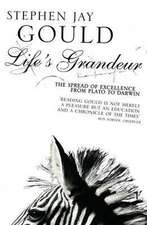The Evolution of Exudativory in Primates: Developments in Primatology: Progress and Prospects
Editat de Anne M. Burrows, Leanne T Nashen Limba Engleză Paperback – 6 noi 2012
| Toate formatele și edițiile | Preț | Express |
|---|---|---|
| Paperback (1) | 945.79 lei 6-8 săpt. | |
| Springer – 6 noi 2012 | 945.79 lei 6-8 săpt. | |
| Hardback (1) | 950.52 lei 6-8 săpt. | |
| Springer – 17 sep 2010 | 950.52 lei 6-8 săpt. |
Din seria Developments in Primatology: Progress and Prospects
- 20%
 Preț: 571.31 lei
Preț: 571.31 lei - 18%
 Preț: 1216.65 lei
Preț: 1216.65 lei - 19%
 Preț: 578.66 lei
Preț: 578.66 lei - 18%
 Preț: 956.69 lei
Preț: 956.69 lei - 18%
 Preț: 948.92 lei
Preț: 948.92 lei - 18%
 Preț: 948.92 lei
Preț: 948.92 lei - 18%
 Preț: 962.66 lei
Preț: 962.66 lei - 18%
 Preț: 1664.43 lei
Preț: 1664.43 lei - 18%
 Preț: 1224.54 lei
Preț: 1224.54 lei - 24%
 Preț: 826.25 lei
Preț: 826.25 lei - 24%
 Preț: 802.74 lei
Preț: 802.74 lei - 18%
 Preț: 1562.94 lei
Preț: 1562.94 lei - 18%
 Preț: 950.21 lei
Preț: 950.21 lei - 18%
 Preț: 943.73 lei
Preț: 943.73 lei - 18%
 Preț: 1549.67 lei
Preț: 1549.67 lei - 18%
 Preț: 1248.20 lei
Preț: 1248.20 lei - 18%
 Preț: 941.38 lei
Preț: 941.38 lei - 24%
 Preț: 800.85 lei
Preț: 800.85 lei - 18%
 Preț: 953.35 lei
Preț: 953.35 lei - 18%
 Preț: 1827.48 lei
Preț: 1827.48 lei - 18%
 Preț: 1209.52 lei
Preț: 1209.52 lei - 18%
 Preț: 957.62 lei
Preț: 957.62 lei - 18%
 Preț: 1231.47 lei
Preț: 1231.47 lei - 18%
 Preț: 1225.48 lei
Preț: 1225.48 lei - 5%
 Preț: 1433.83 lei
Preț: 1433.83 lei - 18%
 Preț: 1231.16 lei
Preț: 1231.16 lei - 18%
 Preț: 1226.90 lei
Preț: 1226.90 lei - 18%
 Preț: 955.25 lei
Preț: 955.25 lei - 18%
 Preț: 956.03 lei
Preț: 956.03 lei - 18%
 Preț: 1218.53 lei
Preț: 1218.53 lei - 18%
 Preț: 950.52 lei
Preț: 950.52 lei -
 Preț: 416.82 lei
Preț: 416.82 lei - 18%
 Preț: 1554.89 lei
Preț: 1554.89 lei
Preț: 945.79 lei
Preț vechi: 1153.39 lei
-18% Nou
Puncte Express: 1419
Preț estimativ în valută:
180.97€ • 189.96$ • 150.21£
180.97€ • 189.96$ • 150.21£
Carte tipărită la comandă
Livrare economică 10-24 aprilie
Preluare comenzi: 021 569.72.76
Specificații
ISBN-13: 9781461426738
ISBN-10: 1461426731
Pagini: 328
Ilustrații: XXII, 306 p.
Dimensiuni: 155 x 235 x 17 mm
Greutate: 0.45 kg
Ediția:2010
Editura: Springer
Colecția Springer
Seria Developments in Primatology: Progress and Prospects
Locul publicării:New York, NY, United States
ISBN-10: 1461426731
Pagini: 328
Ilustrații: XXII, 306 p.
Dimensiuni: 155 x 235 x 17 mm
Greutate: 0.45 kg
Ediția:2010
Editura: Springer
Colecția Springer
Seria Developments in Primatology: Progress and Prospects
Locul publicării:New York, NY, United States
Public țintă
ResearchCuprins
Introduction: Advances and Remaining Sticky Issues in the Understanding of Exudativory in Primates.- Nutritional and Digestive Challenges to Being a Gum-Feeding Primate.- Exudativory in Primates: Interspecific Patterns.- The Ecology of Exudate Production and Exudate Feeding in Saguinus and Callimico.- Influences on Gum Feeding in Primates.- Gummivory in Cheirogaleids: Primitive Retention or Adaptation to Hypervariable Environments?.- Seasonality in Gum and Honeydew Feeding in Gray Mouse Lemurs.- Comparative Ecology of Exudate Feeding by Lorises (Nycticebus, Loris) and Pottos (Perodicticus, Arctocebus).- Exudativory and Primate Skull Form.- A Comparative Analysis of the Articular Cartilage in the Temporomandibular Joint of Gouging and Nongouging New World Monkeys.- Searching for Dental Signals of Exudativory in Galagos.- A Guide to Galago Diversity: Getting a Grip on How Best to Chew Gum.- Tongue Morphology in Infant and Adult Bushbabies (Otolemur spp.).- Adaptive Profile Versus Adaptive Specialization: Fossils and Gummivory in Early Primate Evolution.
Recenzii
From the reviews:
“Exudativory, or exudate-feeding, is a dietary category that is remarkably prevalent among primates. … Morphologist Burrows (Duquesne) and primatologist Nash (Arizona State) have compiled 14 chapters by 29 contributors covering all aspects of exudativory, including nutrition, digestion, ecology, evolution, and morphology (skull, temporomandibular joint, teeth, hands, feet, nails, and tongue). … Summing Up: Recommended. Upper-division undergraduates through professionals in primatology, biological anthropology, and zoology.” (E. J. Sargis, Choice, Vol. 48 (6), February, 2011)
“This book takes a broad perspective and reviews the state of the art of our knowledge on primate exudativory from different view-points. … the book will be of interest and appeal to primate ecologists and evolutionary biologists, and to anthropologists and mammalogists interested in feeding strategies and adaptations. I can highly recommend this book to everyone.” (Eckhard W. Heymann, Folia Primatologica, Vol. 82, 2011)
“Book edited by Anne M. Burrows and Lean T. Nash … is based on a symposium held at the 22nd Congress of the International Primatological Society in Edinburg in 2008. … the book certainly stimulates interesting thoughts and will inspire further in-depth studies on exudativory in primates and other taxa. I do recommend this … book for those interested in primate ecology, functional morphology, and evolution. It will certainly be the major reference on primate exudativory … .” (Melanie Dammhahn, International Journal of Primatology, Vol. 33, 2012)
“Exudativory, or exudate-feeding, is a dietary category that is remarkably prevalent among primates. … Morphologist Burrows (Duquesne) and primatologist Nash (Arizona State) have compiled 14 chapters by 29 contributors covering all aspects of exudativory, including nutrition, digestion, ecology, evolution, and morphology (skull, temporomandibular joint, teeth, hands, feet, nails, and tongue). … Summing Up: Recommended. Upper-division undergraduates through professionals in primatology, biological anthropology, and zoology.” (E. J. Sargis, Choice, Vol. 48 (6), February, 2011)
“This book takes a broad perspective and reviews the state of the art of our knowledge on primate exudativory from different view-points. … the book will be of interest and appeal to primate ecologists and evolutionary biologists, and to anthropologists and mammalogists interested in feeding strategies and adaptations. I can highly recommend this book to everyone.” (Eckhard W. Heymann, Folia Primatologica, Vol. 82, 2011)
“Book edited by Anne M. Burrows and Lean T. Nash … is based on a symposium held at the 22nd Congress of the International Primatological Society in Edinburg in 2008. … the book certainly stimulates interesting thoughts and will inspire further in-depth studies on exudativory in primates and other taxa. I do recommend this … book for those interested in primate ecology, functional morphology, and evolution. It will certainly be the major reference on primate exudativory … .” (Melanie Dammhahn, International Journal of Primatology, Vol. 33, 2012)
Textul de pe ultima copertă
The Evolution of Exudativory in Primates is the first edited volume to offer a comprehensive overview of this rare dietary niche in the primate order. Leading researchers in the field of primatology synthesize our current knowledge of the behavioral, socioecological, nutritional, morphological, and evolutionary aspects of exudate-feeding in primates. The Evolution of Exudativory in Primates covers exudate-feeding in callitrichines, callimicos, mouse lemurs, lorises, and galagos. Advances in our understanding of how these animals obtain their food and digest it, how this food resource affects social relationships, and how morphology is related to exudate-feeding are presented in subsequent essays. The final chapter synthesizes current data on what role exudate-feeding may have played in the earliest primates, the plesiadapiforms, and what exudate-feeding signals may be present in the fossil record.Ideal for upper-level undergraduate and graduate primatology courses, The Evolution of Exudativory in Primates can also be used for courses in biology, comparative mammalogy, and conservation. About the Editors:ANNE M. BURROWS is an Associate Professor in the Department of Physical Therapy at Duquesne University and a Research Associate Professor in the Department of Anthropology at the University of Pittsburgh. She has worked on the functional and evolutionary morphology of the primate craniofacial complex with a focus on strepsirrhines. LEANNE T. NASH is a Professor of Anthropology in the School of Human Evolution and Social Change at Arizona State University. She has worked extensively with a captive colony of Galago senegalensis held previously at ASU for 20 years. She has also done fieldwork in Africa and Madagascar on baboons, galagos, and sportive lemurs. Other collaborations have been on captive chimpanzee behavior with the Primate Foundation of Arizona.
Caracteristici
The fourteen chapters effectively review current information from a wide array of disciplines Provides pointers to future research Represents a watershed in our understanding of exudativory in primates Includes supplementary material: sn.pub/extras















